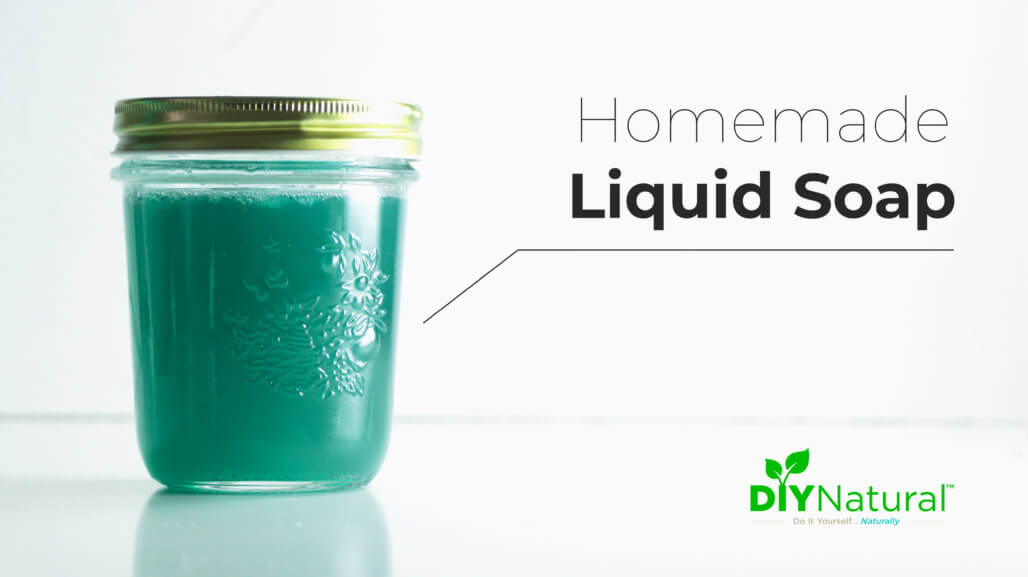
Learn how to make liquid soap. Not grated bar soap melted in hot water. Our recipe masters REAL liquid soap for hands, body, dishes, & more!
Summer is almost here and school is out, for that reason I have plenty of time to work on projects.
After mastering both cold and hot process soap making, the next step was to learn how to make liquid soap.
Sure, you can just grate some bar soap and pour hot water over it. As a result after a few days, a gel will form and you’ll have liquid soap. But wouldn’t you rather learn how to make liquid soap that is perfect for use as shampoo, body wash, and dish soap?
I’ve figured it all out for you! And after a lot of trial and error, I finally formulated a recipe that is much easier and less time-consuming than my first few attempts! It also has perfect moisture, texture, and shelf-life.
Liquid Soap Ingredients
Like hot and cold process soap, there is an alkali component and an oil component.
For liquid soap, the alkali component is a bit different. Sodium hydroxide is used to make hard bar soap while potassium hydroxide is used to make liquid soap. Potassium hydroxide is harder to find and comes in flakes, not beads. The flakes are easier to work with but are still caustic, so you must wear gloves and protective eyewear.
The other ingredients include coconut oil, olive oil, rice bran oil, another oil such as soybean (there are a few non-GMO brands available), safflower or grapeseed oil, sunflower oil, distilled water, liquid vegetable glycerin, and any scent or color you wish to add. You can source all of these ingredients organically except potassium hydroxide.
Note: When learning how to make liquid soap many people are concerned about lye. You can rest easy knowing that all potassium hydroxide is eliminated during the soapmaking process through a reaction called saponification. It’s no longer caustic at this point.
Equipment
When you make liquid soap it takes a lot of equipment and ingredients! Like hot process soap making, you’ll need a slow cooker, a stick blender, quart jar (I use a wide mouth jar), a potato masher, and silicone stirring spoons. And since this recipe is measured in ounces, you will need a kitchen scale.
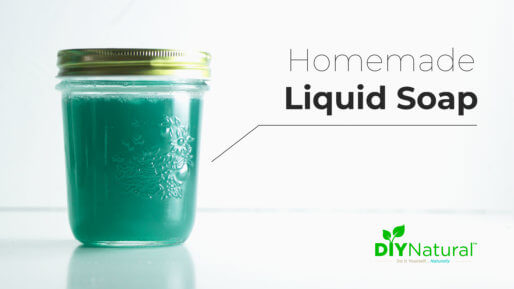
How to Make Liquid Soap: The Recipe
Learn how to make liquid soap. Not grated bar soap melted in hot water. Our recipe masters REAL liquid soap for hands, body, dishes, & more!
- Prep Time
- 30 minutes
- Active Time
- 6 hours
- Clean up time
- 30 minutes
- Total Time
- 7 hours
- Estimated Cost
- $8
Equipment
Ingredients
- 10 ounces unrefined coconut oil
- 10 ounces olive oil
- 3 ounces rice bran oil
- 13 ounces other oil I use safflower and grapeseed oils if I'm making a body soap, or soybean oil if I'm making a dish or laundry soap
- 5.5 ounces sunflower oil
- 9 ounces lye (potassium hydroxide or KOH is the only type of lye we use for soapmaking)
- 25 ounces distilled water
- 60 ounces distilled water (for diluting the soap paste)
- 16 ounces liquid vegetable glycerine
- 3 ounces essential oil (more or less to your taste of essential oil or fragrance oil of your choice, lavender is my favorite)
- natural colorant of your choice (use a very small amount – ideas for natural soap colorants)
Instructions
Liquid Soap Process
-
The first lessons for how to make liquid soap are to ventilate your work area well, cover your workspace with newspaper, and put on your gloves and goggles. Be sure pets and kids are not running underfoot as you begin this project.
-
Start by measuring your oils and placing them into the crockpot. Remember: For this recipe, we're measuring all ingredients by weight, not by volume, so you must have a scale (like this).
-
Turn your slow cooker on high and melt all the oils. I use a smaller slow cooker to cook my ingredients down and then move to a larger one once I start adding the liquids.
-
Place 25 ounces of the distilled water into a glass or stainless bowl. Measure out the lye and slowly pour it into the water (never the other way around) while stirring. You may notice it making groaning noises as it dissolves; this is normal. You cannot make this liquid soap without lye; see more below.
-
Once mixed, add the water/lye mixture to the oils. Combine by hand to blend the solutions, then start using the stick blender (immersion blender). The mixture will be kind of chunky and want to separate, but don't worry. Blend for about 5 minutes, then walk away.
-
Cover and keep on high for the first 30-60 minutes, then turn to low. No trace required for this liquid soap making recipe.
-
Keep coming back once in a while to stir or blend. It will start to take shape soon. After about 2 hours it will look kind of translucent like petroleum jelly. By this point, it is harder to work with – heavy and sticky. I use a stainless steel potato masher to break it up more easily. Once it looks cooked through with no opaque spots, you can test it.
-
To test: place a small spoonful in some hot water and stir really well. It'll take a bit to dissolve it all. If the water is clear, you can continue to the dilution stage. If it's at all cloudy, continue cooking. Isn't learning how to make liquid soap fun?
Liquid Soap Dilution
-
Once your soap paste is fully cooked, you can dilute it.
-
Heat 60 ounces of water until hot; do not boil. (Remember to measure by weight, not volume.)
-
Add the liquid vegetable glycerin. Mix together well.
-
Add this mixture to the slow cooker and stir, or use the masher if needed. Leave on low, cover, and walk away. You can leave it for a few hours and then go back to it. I like to do this step in the evening so I can leave it overnight.
-
In the morning, stir the soap well and let it settle for an hour or so. The soap paste that's not diluted should rise to the top, leaving good liquid soap underneath. I push the chunky stuff aside and spoon the good stuff into pint or quart jars. Then I can scent and color each one differently if I want to. Remember, this recipe will make about 9 pints or 5 quarts, so divide the 3 ounces of essential oil (and your natural colorants) evenly between all jars. And yes, you can use different oils and colors in each one. Lastly, remember to use tiny amounts of colorants at first, then add more if you want. Coloring and scents were my favorite part of learning how to make liquid soap.
-
Always be sure to keep track of what you add and how much. I keep all my notes on 3×5 cards and record each batch, even if I’ve made it a dozen times before. That way I can keep each batch consistent or change things as I like.
-
For the chunky stuff that remains, add a bit more water and turn the heat off. Leave this overnight and it should all be diluted by morning. Depending on the consistency you want, you may need to add a bit more distilled water. Start with a very small amount (1 tsp) so it doesn't get too thin.
Recipe Video
Notes
Now that you know how to make liquid soap, look here to find bottles, pumps, and other dispensers for this liquid soap recipe!
And remember, ALL ingredients are to be measured by WEIGHT!
Made this recipe?
Mention @diynatural or tag it #diynatural!
Is Lye Necessary for Soap?
Is lye, also known as NaOH and caustic soda, absolutely necessary when making soap? Yes and no. For more information read our article on can you make soap without lye?
Using Your Homemade Liquid Soap
I use this liquid soap as shampoo, body wash, dish soap, and hand soap. Next, I’ll be adding essential oils to make a dog shampoo. They have slightly more acidic skin, so I’ll be adding a bit of lemon juice to the shampoo just before I use it.
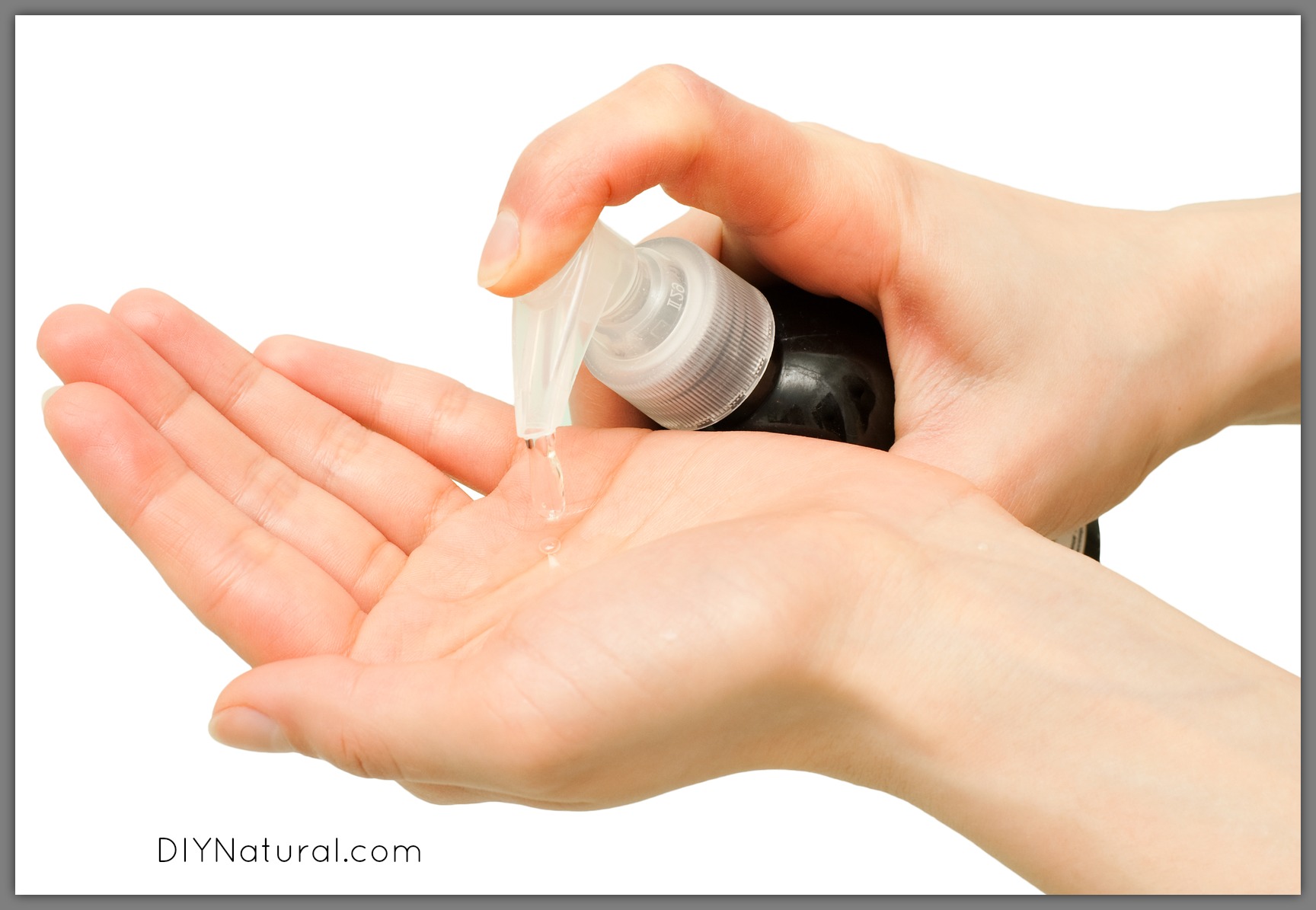
More Soap Recipes and Soap Making Info
If you’d like more information on soap making, check out our other articles here:
- Homemade All-Natural Soap for Face and Body
- Homemade Natural Soap for DIY Cleaning Recipes
- The Secret to Making Soap in a Slow Cooker
- 44 Ways to Color Homemade Soap Naturally
- Fun & Easy Substitutions for Making Soap at Home
- Soapmaking Calculator
Have you tried making liquid soap?
How did it turn out? Share with us in the comments below.
*******
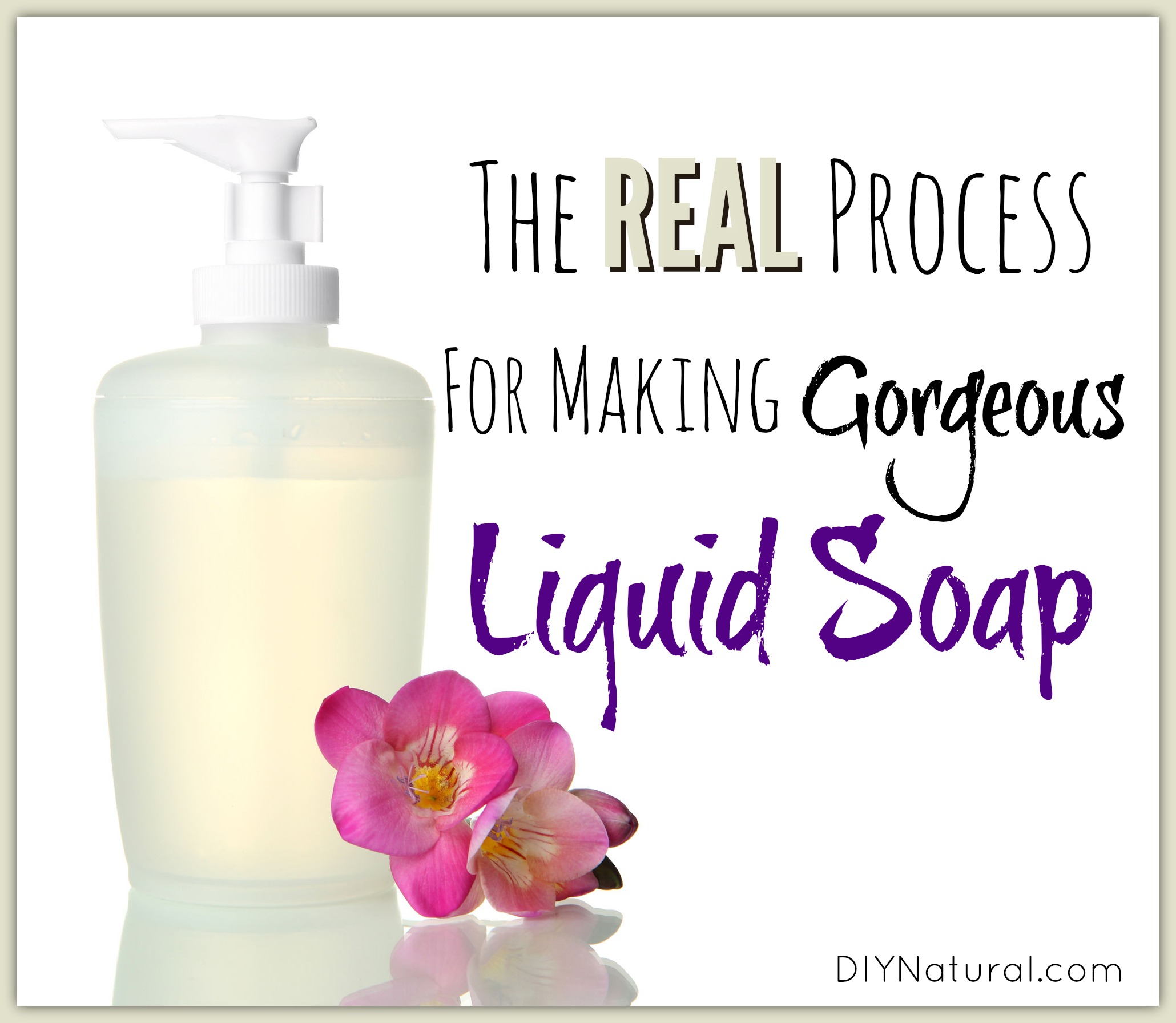
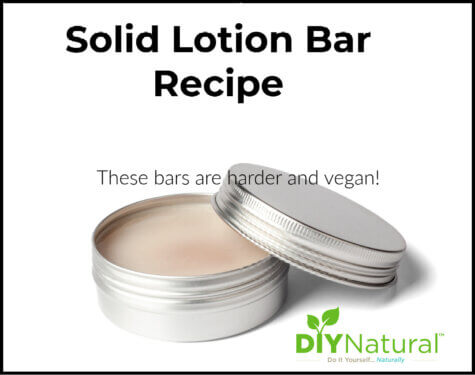
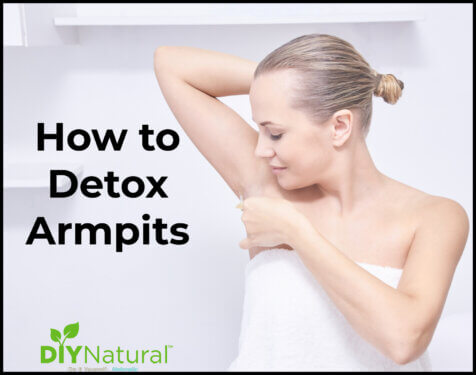

I made my first batch of your soap. I thought it was going good until……… I spooned the liquid soap into pint jars and I ended up with a total of 9 with the remains still melting in the crock pot. I took an ounce of lavender oil and put in the first jar to fragrance and it started to thicken up . Then I added color to one jar and it thickened up even worse so that it back to the consistency it was before it cooked in the crock pot overnight, Your instructions say and I quote:: I spoon the good stuff it pint or quart jars. Then I can scent or color each one differently if I want.” Questions:
1.Can you add essential oil and color when they are still warm? Or must they be cooled?
2.How much essential oil per pint of soap?
3.How much color per pint jar.
4. How do I reclaim the ones that have thickened or am I just out of luck and wasted all that material.
5. Your recipe said 3 0z of essential oil – for the entire batch???? OR???
6, Beginners such as myself need to have explicit instructions down to the last drop and not leave anything to our guessing
I think the soap will be great if I can get past this point, Please respond ASAP!
Hey Glenda, not sure if this is helpful. But I would reheat the mixture that thickened too much and mix in a teaspoon of distilled water at a time.
I did just that and it took considerable more water. What kind/brand of colorant is good for this recipe?
Hello Debra, I was wondering how much soap this will yield? This is my first time making liquid soap and I could not locate on the recipe how much soap I would make. Thank you!
Hi Debra,
I’m confused about the comments regarding borax. Neither the ingredient list nor the directions says anything about borax, but you and several others have mentioned it in the comments. Am I missing something?
Lori, I was going to ask the same question. Debra, can you please comment on the borax, as well as what the purpose of the vegetable glycerin is? Thanks!!
Hi ladies,
Originally we published Debra’s article on liquid soap. Then, sometime later she released an updated recipe that was simplified and no longer needed borax. To simplify things we removed the original article and updated this one to be the best recipe for liquid soap. Hope this helps!
Blessings,
—
Matt
Thanks Matt! Yes, it’s true that you no longer need to use borax as a neutralizer. I’m just finishing up a 4th class making this recipe and my students and I still have not needed to neutralize it. It works great just as it is. The glycerin is used as a solvent to dissolve the soap paste. Back when I started making soap, the solvents used were alcohol, like 95% Everclear, and sugar. Everclear is very flammable, so I looked for something safer, and found it in glycerin.
I’ve never made soap before. Could this recipe be scaled to make a smaller “test” batch”? Thank you.
It sure can, Veee! I use half this batch as a recipe for the classes that I teach. It’s easier for a first time liquid soap maker to handle. Half the batch will make about 3/4 gallon. You can go to 1/4 of the batch. But…most crock pots heat on the sides, not the bottom, so heating may be difficult. A smaller crock pot may work well in this case.
I’m really interested in trying the soap recipe but I’m going to have to buy all of every thing so about what am I looking at for price ? Can all this be bought at health food stores and or Wal-Mart ? I’ve been making my own laundry soap for years so thought this would be fun and different. Thank you. I don’t order on line and I’m 3 hours from the nearest decent size town.
You can get most everything at your local stores, Debra, except for the potassium hydroxide. That is the only ingredient I can’t find locally and most others can’t either. If you don’t order online, most places that sell it online will take a check or cashiers check through the mail and ship it to you.
Great, Thank you so much! I feel better now and will try the recipe out!
Hello! Great info, so Thank You! I have a question regarding the use of coconut oil. I was told that coconut oil clocks your pipes. Have you researched this before creating your liquid soap recipe? I’m concerned about using it.
Sorry, i meant to type that it CLOGS your pipes!
I’ve never had a problem with clogged pipes, Patti. It’s probably because coconut oil on it’s own becomes hard when it gets cold, where as the coconut oil in soap has changed into soap and is no longer a solid oil. In my 20+ years of soap making, I’ve only gotten clogged pipes from long hair getting stuck in the drain pipes. Soap can coat these hairs and cause them to stick, making you need a good drain cleaner. You can refer to my article here at DIY Natural if you need help with clogged pipes!
I was wondering why there are several measurements of water for this recipe. I read the directions and there doesn’t seem to be separate steps to add the different measurements of water. Did I miss something or is all the water added in the initial stage?
It is a mixture and not a chemical formula. Some people like more suds, less suds, more liquid, etc. The amounts are only approximations as it is a mixture. Mix it up and find out what proportions you like and write it down for the next batch. For example, I make my own washing detergent that will last for several years. The proportions are one grated bar of Felds Naptha soap, one cup of Borax and one cup of washing soda. I don’t want a 1/4 box of this or that laying around. So, I freeze the soap after it has air dried for a few months. I grind up 10 bars of Felds in my Kitchen Aid grinder and add one box of borax and one box of washing soda. Nothing is left over and I’m left with a bucket of dry detergent. I never use more than 3 tablespoons a load. I’m set for a few years at 6 cents a load. Regular detergent is 60 cents a load. No plastic containers are left over. No lugging detergent in from the store for a few years.
That wasn’t my question. The are three measurements for water and no mention of separate stages to add them. It’s not the quantity but why there are 3 measurements and no mention of when to add these separate quantities or if they all get put in at the same time.
The instructions say to weigh the 5.5 oz. water with the potassium hydroxide in a quart jar.
The instructions say to bring the 40 oz. of water to a boil and add all the soap paste and stir.
Then the instructions say to boil the 6 oz. water and add the borax and use that mixture to neutralize the soap mixture but my question was the instructions ask for more water/borax at the end than the instructions say. I was told to mix it and use what is needed because sometimes more neutralizing is necessary and to test with a pH indicator.
Hope this helps you 🙂
Thanks Kathy! I just explained it before I saw your post. I think we both said the same thing!
Also, it IS a chemical formula. Measurements wouldn’t be required otherwise. This is a chemical reaction, not making a mud pie.
Hi Peter! No, you didn’t miss anything. The first measurement of water is for the initial process. Then, after the “paste” forms, you’ll need to dilute it. This is the second amount of water. After it cooks down and becomes more liquid, you’ll need to neutralize it. The third amount of water is to mix the borax into. The amount you use is up to you, but for this size batch, I use about 2 ounces of diluted borax and water. You can check the pH with a meter or pH test strips.
Hope this helps!
I make my own liquid soap, but I never heard about neutralizing it with borax. What ph is the soap will be after it will be neutralized with Borax? Also, you mentioned you use it as shampoo as well, but the shampoo have to be neutral, as I know. Is it around 7?
Hi Veronika! I’ve tried several methods for lowering the pH in soaps and none of them get it down as far as 7. In the liquid soaps, the pH will go down to 8-9 which is far better for your skin than 10 or so where it is naturally after the soap making process. I’ve tried lemon juice and vinegar, but these cause the soap to separate. I’m happy with the results of around 8 or so.
I’m confused by “weigh the water.” Usually ounces of water means liquid volume. Are you saying these ounces are measured by weight on a scale, and not by volume with a measuring cup?
Good point, Roger. In my cold process soap making recipe, I used cups, because I had done all the weighing for you. I simplified it to make it easier to do. In most recipes ounces are used, sometimes grams. And these are weighed ounces, not measured. And ounce of oil will weigh different than an ounce of volume. So always weigh your ingredients unless indicated to do differently.
Thanks!
Water has a density of 1 (specific gravity), so that is the one substance that will end up being the same whether you measure in volume or mass (weight).
Interesting read for those looking for the best commercial dish washing soap from Consumer reports. http://pittsburgh.cbslocal.com/2011/04/19/consumer-reports-puts-dishwashing-liquids-to-the-test/
Hello – love the idea of making my own liquid soap. I’ve been making my own bar soap for a few years now and love the result 🙂 My question is regarding the ingredients list…3 oz. borax and 6 oz. water. Down farther in the instructions it says to use 1 oz. borax and 2 oz. water…which is right?
Actually, Kathy, either is right since the proportion is the same. Some people feel the need for more neutralizing solution, so more may be necessary. You can test your mixture with a pH indicator test. If it’s too alkaline after you add the initial 2 ounces of borax solution, you can add a bit more, but no more than 6 ounces. I usually find that 2 ounces is plenty.
Many thanks!
I also want to know if there is a good substitute for the coconut oil! My girlfriend is allergic, and I want to make something we both can use!
Because different oils saponify at different rates and have different fatty acid components, you should never substitute oils in soap recipes. The amount of lye and water has to be recalculated carefully. Coconut oil is in most liquid soap recipes because the lauric acid provides most of the lather. Palm oil has a similar lauric acid profile, but requires less lye.
That’s right, Erin. I mentioned above that the oils should not be switched out because of the SAP value and if you do, run them through a lye calculator to be sure you have the right amount. I have known some people that are allergic to coconut to be able to use hand crafted soap. The coconut oil goes through a transformation and may be ok for some people who do not have severe allergies. I would only recommend this under that care of a doctor.
I have a trick for not disturbing the sediment at the bottom when dispensing liquid to smaller bottles: use a glass gallon jar that has a spout at the bottom like a tea dispenser. You can usually find a used jar at thrift stores. I’ve never made liquid soap so I do not know how much sediment is accumulated at the bottom, but I would think it would be less than the level of the spout.
Thank you for all your hard work and great ideas.
That’s so smart! Thanks Vicky! I would never have thought of that. I’m going to try it with my next batch. Thanks so much for sharing.
This sounds great!
I do have one question, though — I always thought that water-based liquid soaps required a preservative, because bacteria will grow in liquid soaps (unlike hard bar soaps). This recipe does not have a preservative. Can you explain your reasoning? Thank you so much!
Hi Jen,
I’ve never used a preservative and my soap holds up well. I don’t superfat, so that may be one reason. You could try citric acid if you want, but sometimes it causes mass separation. I do use sunflower oil which has a large amount of vitamin E, which has been used as a preservative. When I do liquid soap, I substitute 2 ounces of olive oil with 2 ounces of sunflower oil. Seems to work just fine. You could also try ROE (rosemary oil extract).
Nice to see this answer. I’ve read that preservative is optional for liquid soap. I’ve made my own liquid soap and I don’t want to use preservative. My question is, how long do you think it will last? Thank you so much for the video and your response.
Almost four in the morning, and I’ve been going over a chapter in my next book. This section raves on the wonders of soap, which makes you feel glad all over. Fire’s pretty good stuff and the wheel is handy enough, but you have to be careful with both. I made a batch of soap myself using a family recipe of Granny Clampett’s, and wisely tested it before using it. Strong enough to remove a tan, with a stench like Lucifer’s underarm. Tonight, always reluctant to bother busy divine beings with the small stuff, I was actually praying for lucid instructions on how real soap that was real good could be made by my own dirty hands. Voila, bingo, and angel choirs, my Inbox dinged and you answered my question. As if more proof of a benign universe were necessary. With your kind permission, assuming my book ever sells, I’d like to Acknowledge your help of unmet friends and Gaia-oriented values, the subtext of said book-to-be-one-hopes. Happy D-day and keep up the good works, please.
Thanks so much Geoffrey! I love being able to help people. If your book ever sells, I want a copy!! Sure, you have my permission. And if I can help with anything else, just let me know.
love this blog, make all my own things, but have severe allergy to cocoanut since I was born, 77 years ago. Is there something that can be substituted for it?
Unfortunately, Joy, there is nothing that works as well as coconut oil. It’s the only thing that produces the lather that is fluffy as well as cleansing. You can omit the coconut oil in hard bar soaps, but I’m not sure about liquid soaps. Some hard bar recipes say that you can substitute palm kernel oil (not palm oil) for coconut, so you might want to try that. The SAP values (the amount of potassium hydroxide needed to make a particular oil into soap) differ, so I’d run it through a lye calculator to be sure.
OUT OF CURIOSITY AFTER ALL THE EXTENSIVE RESEARCH IVE DONE ON MANY OF THE BASIC OILS USED IN SOAP MAKING,I AGREE THAT COCONUT OIL IS ONE OF A HANDFUL OF OILS THAT ARE GENERALLY USED IN ALMOST ALL SOAP RECIPES BUT MUCH OF WHAT I READ CLAIMS A COMBINATION W/OVER 30% COCONUT OIL CAN BE EXTREMELY DRYING TO THE SKIN BECAUSE OF ITS POWERFUL DEGREASING ABILITY-AS IN,IT COULD REMOVE ALL NATURAL OILS WHICH ISNT WHAT MOST PPL ARE LOOKING FOR IN A SOAP-YOU HAVENT NOTED THAT AS A BODY BAR TYPE SOAP AN OVER ABUNDANCE OF COCONUT OIL BEING EXCESSIVELY DRYING??
MY APOLOGIES-I MISREAD YOUR REPLY TO THE ABOVE QUESTION,SORRY!!:)
It’s a commonly held thought that coconut oil is drying, Amy, but if used correctly, there shoulodn’t be a problem. I use 25-33% coconut oil in my recipes for just this reason. Coconut oil creates lather. If there is too much lathering ability, it can pull too much moisture, and protective oils, out of the skin. At these percentages, it keeps the lather at a lower level and doesn’t clean the skin of all the oils in it, only the surface oils, which is what we all want to get rid of when we use soap. Hope this helps!
Yes, I’ve made liquid laundry soap from soap nuts. Boil 4 cups of water, remove from heat, add 1/2 cup of soap nuts (bits or whole) and let soak overnight. Strain into a quart mason jar and store in the refrigerator (although I left mine near the laundry tub for 2 weeks and it was fine).
Soap nuts! Thanks Lee Ann, I’d forgotten about those. I still have some in my laundry room.
hi! can u give us another measurements for this recipe? me and my groupmates are going to have this for our organic chemistry but the measurements are too big and it is expensive for us. thank you
Add up the amounts and find the percentages. You can then reduce it and play around with it the sizing however you want
How does the liquid soap recipe satisfy healthy and natural criterion. It doesn’t seem to differ from natural soaps available everywhere. Why would I make something with potash in it anyway? Might as well use lye or buy it.